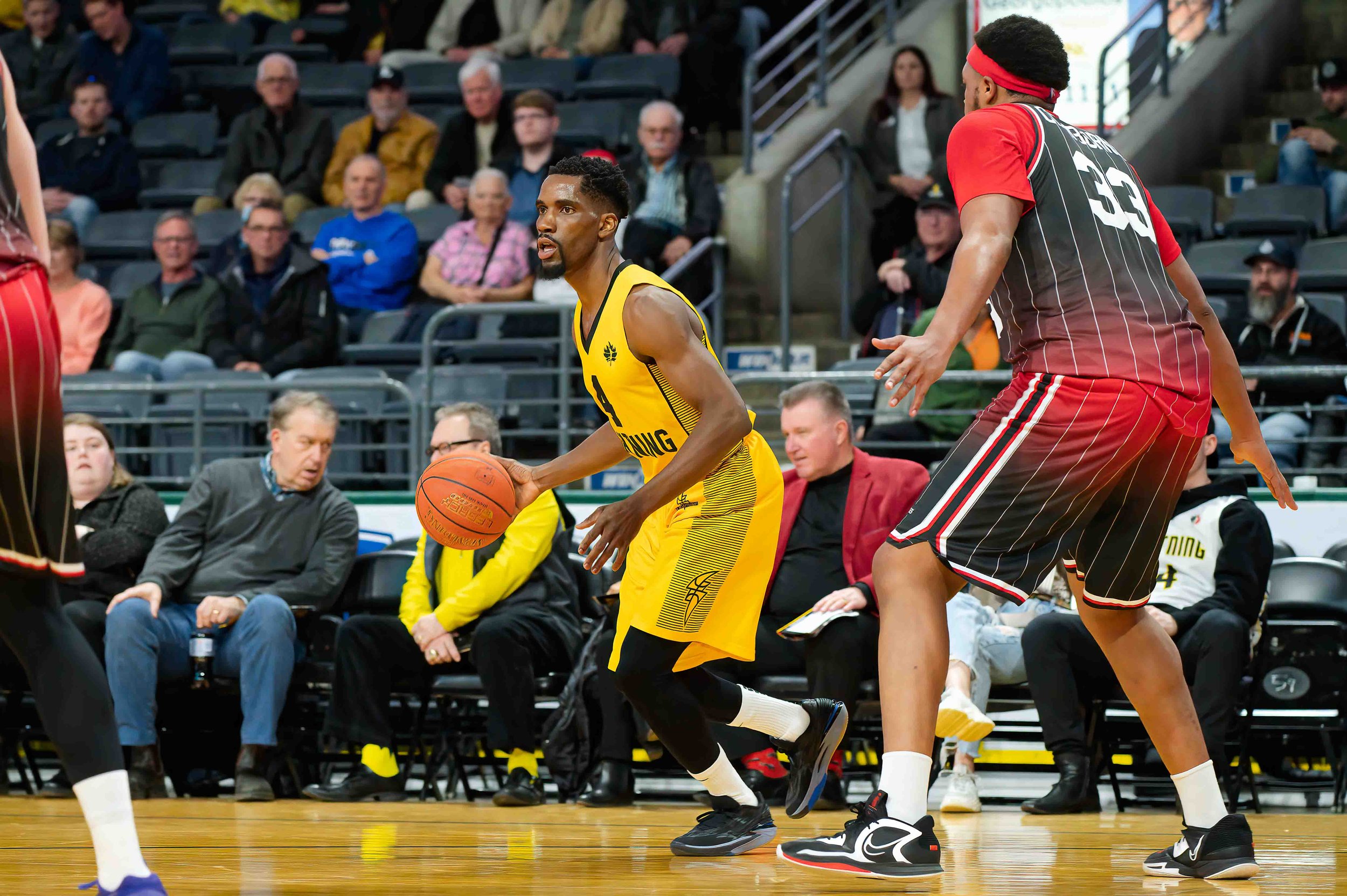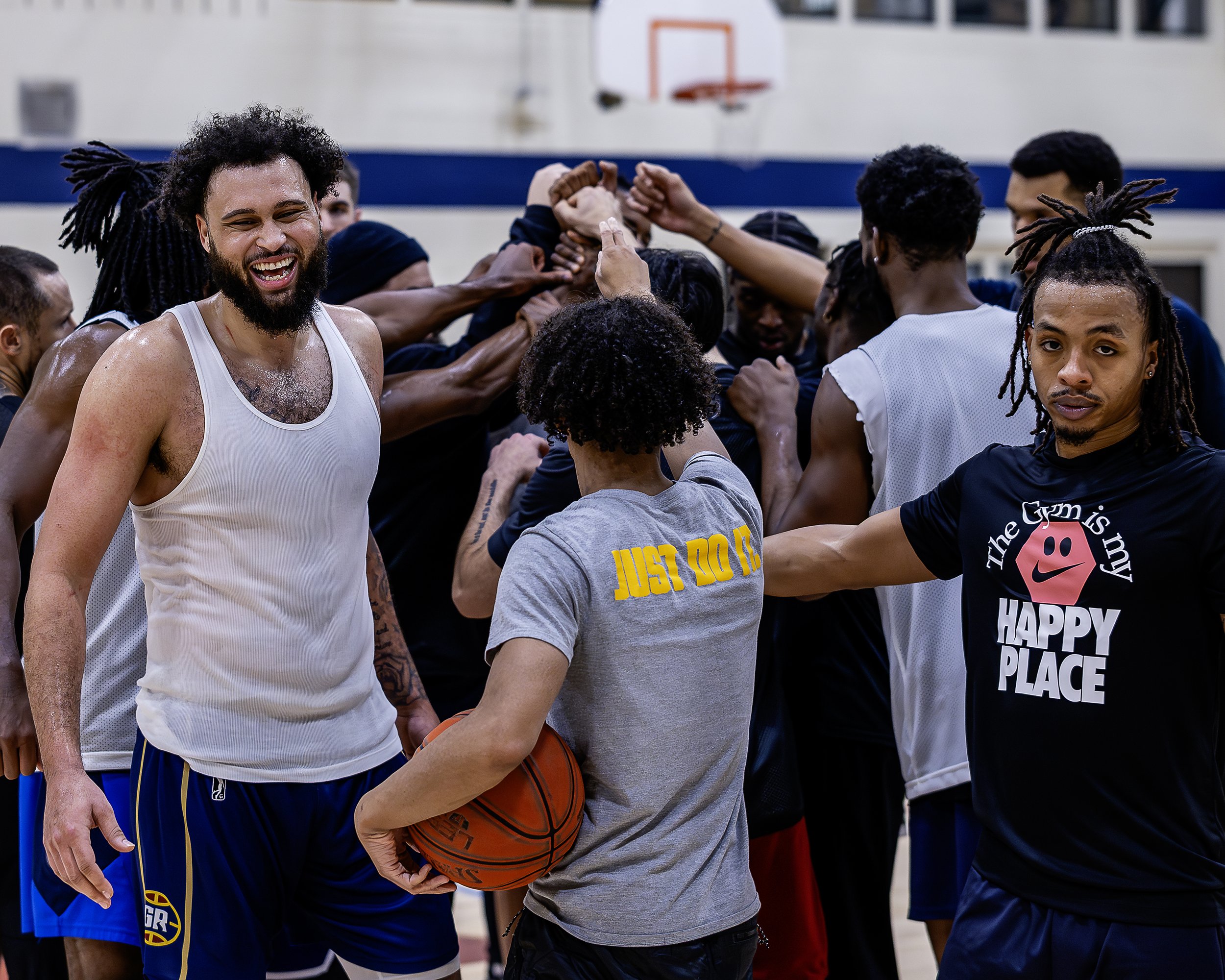Lightning to navigate new league — and new rules
In a new league for 2023-24, the biggest adjustment early on for the London Lightning may be a new rule — a defensive three-second violation. That could change the flow of the game — and affect strategy …
(Photo: Matt Hiscox Photography).
* * *
When the London Lightning open Basketball Super League (BSL) play next week, it will be under a slightly different set of rules from the now-defunct NBL Canada. The new league will be played under rules, described by David Magley, BSL President, as “basically NBA rules with a sprinkling of some FIBA flavour.”
Perhaps the biggest change for NBL Canada teams arriving in the BSL will be enforcement of a defensive three-seconds rule, essentially eliminating zone defenses and injecting some new flows – and maybe even a few questions – into the game.
* * *
“A lot of people don’t like change. Players don’t. Coaches don’t,” said Carlnel Wiley Jr., The Basketball League (TBL) Commissioner, who has been working with BSL officials to explain the rule to teams in the new league. “The rules of the game make us pros, make our game different. To become a pro, you need to understand that rules change because the game changes – and as the game changes, so does the language of the game. It used to be illegal defense. Now, it’s defensive three-seconds. What’s important is that we understand what goes into it.”
So, what exactly is defensive three seconds? Let’s look at the basics.
In effect in the NBA since 2001, defensive three seconds was designed to open the game and unclog the lane by preventing defenders from planting themselves beneath the basket.
Under the defensive three seconds rules, when a defender is in the paint, they must be “actively guarding an opponent within three seconds. Actively guarding means being within arm’s length of an offensive player and in a guarding position,” according to the rule book.
The three-seconds count starts when the offense controls the ball in the frontcourt. It stops if one of the following happens:
1. A player is in the act of shooting;
2. Loss of team control;
3. Defender is actively guarding an opponent;
4. Defender completely clears the lane; or
5. It is imminent defender will become legal.
If the defender gets whistled for defensive three seconds, a technical foul is assessed, resulting in a free throw and possession of the ball for the opposing team.
So, how does a defender avoid defensive three seconds?
A defender can hang out in the paint forever if they are guarding the player in possession of the ball. Once the player gives up the ball, however, the defender must either “actively guard” them or clear the lane.
You aren’t wrong if you feel the phrase “actively guard” seems a tad squishy.
“Don’t overcomplicate or overthink,” Wiley said. “Last year, the rule was that your hands needed to be out, you needed to be effectively guarding someone with knees bent. They were saying your knees needed to be bent this way, that way and the other. It was that much. Now, it’s not that. Now, you have to show that you’re with your man. It’s just that simple.”
When it comes to the rule, players have injected just as much art as science into pressing defensive three-second rules to the limit.
Take ‘cleansing.’ That’s the act of a defender in the paint touching someone he’s not defending as they cut around him to ‘cleanse’ himself of the three-seconds count because he’s technically “actively guarding an opponent.”
Or ‘two-nineing.’ That’s when the defender takes a step outside of the key for a split-second – at 2.9 seconds, you see – to reset the defensive three-seconds count.
The rule can occasionally create some interesting strategic matchups. For instance, some teams may use their best shot blocker to defend the weakest shooter on the opposing team (even if they play a different position) so the defender can stay closer to the basket.
Make sense? Yeah, I know. There seems to be a lot of room for interpretation.
The Lightning compete at a practice Dec. 15, 2023 in preparation for their inaugural season in the new Basketball Super League. (Photo: Barry Field Photography).
* * *
Loosely modelled on the premiere professional soccer league in Europe, the BSL brings together the top teams from the former NBL Canada and the U.S.-based TBL, with six teams set for the 2023-24 season.
Canada is the dominant geography of the league, with the four former NBL Canada teams, along with the TBL’s Newfoundland Rogues (St. John’s) and Montreal Toundra joining.
London will play a 32-game schedule, with 20 home games, starting on Dec. 28 in Sudbury. The league’s regular season schedule also features 13 TBL franchises crossing over to play BSL opponents. The Bolts will face five TBL opponents – the Connecticut Crusaders, LA Ignite, Pontiac Pharaohs, Rhode Island Kraken, and West Virginia Grind.
The TBL already plays with the defensive three seconds rule, and so the BSL has embraced the rule to better align with the TBL and global play, as well as keep its game on par with fundamental changes to the game itself.
“The game has changed so much,” Wiley said. “Go back to the 1980s. Listen, don’t get it twisted, I still watch my old games. I love to watch the Showtime Lakers, to this day. But if you look at that era, there’s so much action in the paint. Not anymore. Everything is outside. Look at the shooting charts. There is so much going on outside the three-point line. You get a few in the paint, but you have all these other shots outside the three-point line. That’s where the game is now.”
For the NBL Canada teams joining the BSL, the rule will take some adjustment. Lightning head coach Doug Plumb has been going “back and forth” on how he wants to approach the change.
“Yes, there’s a defensive three-seconds in the key, but if you’re smart, your principles remain the same. It does put more of a premium on a big that can move, a big that can talk. It does put a premium on intelligence off the ball, because there will be flashes out of the paint or flashes strong side.”
(Photo: Barry Field Photography).
Fans might notice some approaches uncommon to a Plumb-coached squad, like doubling in the post if the ball goes to the block.
“But for all intents and purposes, we have had a pretty good run here defensively. What that comes down to is that we have the right people in place. You can scheme all you want defensively, but if you have a big that cannot move or guards that cannot defend, it doesn’t matter if we have three in the key or not, you are going to be screwed.”
Plumb rattled off seven or eight players in camp who might, in fact, thrive under the new rules, including frontcourt leaders Jeremiah Mordi, Ben Mockford, and Marcus Ottey.
“I like what we have. We have really good pieces,” he said. “It’ll take some time to adjust, sure. But I think everyone will be going through a bit of a learning curve.”
On the flip side, Plumb is excited at the challenges his squad can pose for opponents. A roster loaded with smaller playmakers might create havoc for defenses just figuring things out. The Lightning have two true centres on the squad, Amir Yusuf, listed at 6-foot-8, and Angus McWilliam, listed at 6-foot-10.
In addition to the league, Plumb sees personal potential in the new rule.
“As a coach, I’m excited about the changes. I want to coach in the NBA one day. I have coached a European offensive and defensive system for a long time. That’s why I’ve had success here. Now, I need to pivot a bit on the fly, tweak certain things. It’s a good challenge for me,” he explained.
Plumb continued, “The last couple of years, I didn’t know if I was getting better from a professional sense. I had a good formula that worked for that league, and I just had to duplicate it by making sure I had the right pieces in the right places. Now, I need to become more versatile as a coach. I’m excited about that.”
(Photo: Barry Field Photography).
* * *
The leaguewide education on the rule has involved individual, team, league, media, and other stakeholders, using NBA clips to get a better understanding of it.
Wiley will know his rule evangelism worked if nobody notices the new rule once play begins.
“We always talk about communication, but I want to add something with that. We want communication and comprehension. I could communicate with you everything. But I also have to know that you understand what I’m saying.”
He continued, “If a coach doesn’t know the rule, and players don’t understand the rule, doesn’t it become ineffective? Yes. But if we understand our rules, it makes us so much better – better coaches, better players, a better game itself. It just all in all makes it better.”
Obviously, the officiating crews will play a huge part in the understanding and enforcing of the rule – something you wouldn’t be wrong to suspect will have a bumpy rollout in the first few games.
“Referees need to be very vocal with this rule at first and say, ‘Coach, I hear you off to the side, but I felt he was guarding him and that’s the understanding, OK?’” Wiley said. “If you’re a referee, a coach, or a player, understanding the rules and abiding by them will make you better and the game better.”














Around the Perimeter: London and KW are the final two teams standing. It’s experience vs. youth; Will Lightning match the Titans’ energy?; Will defense decide this matchup? Read our series preview …